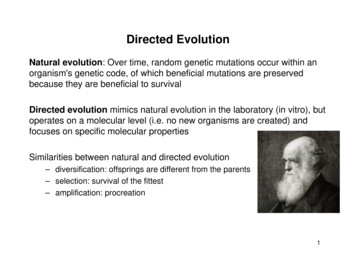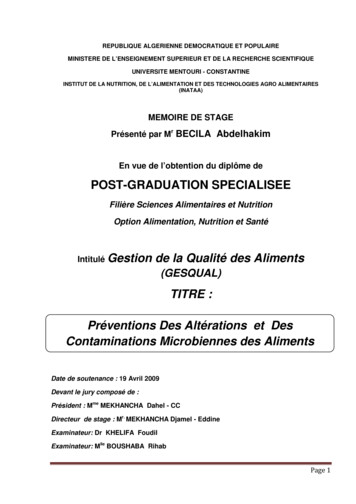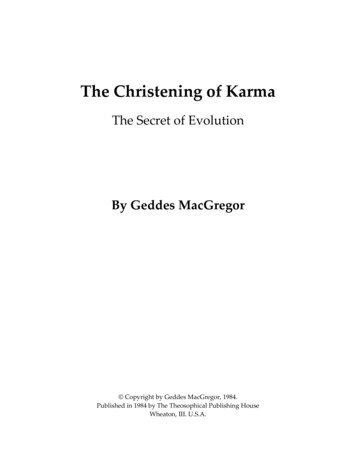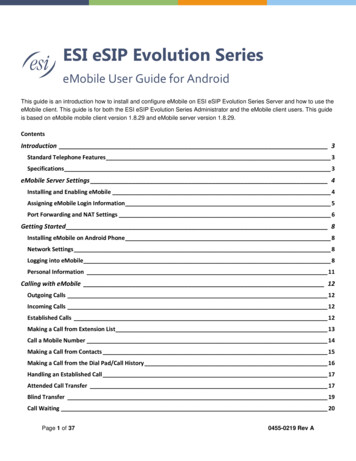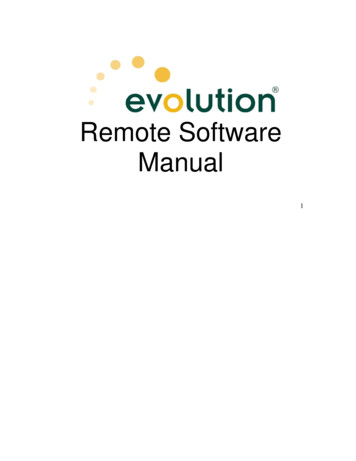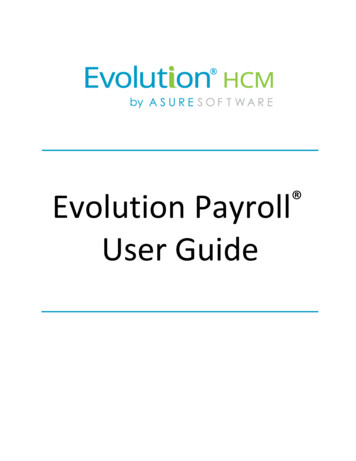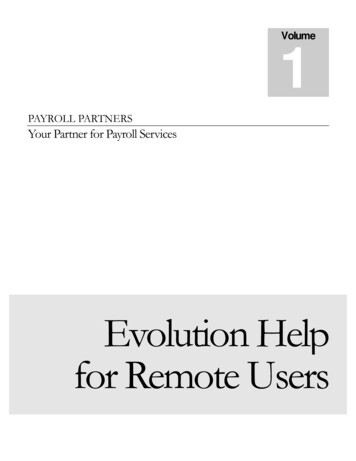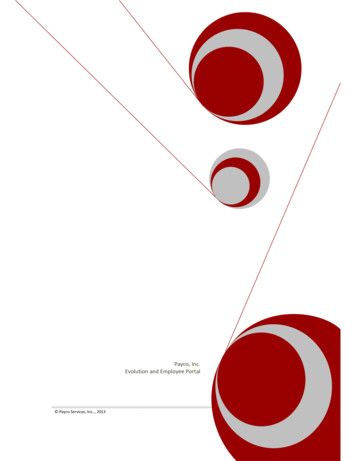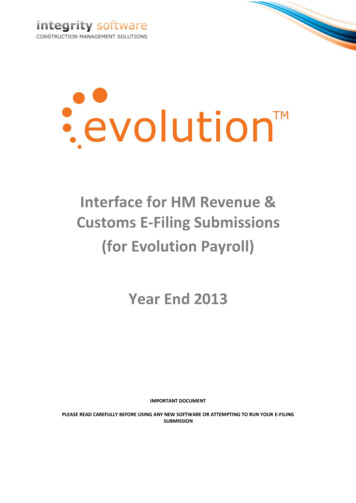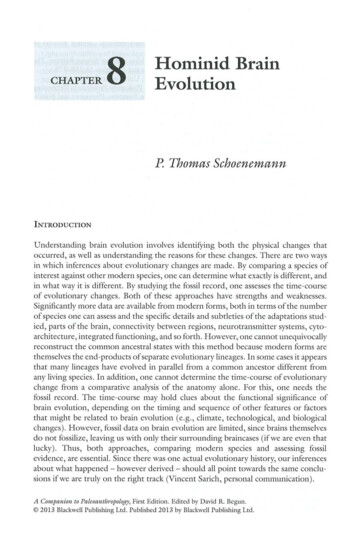
Transcription
New Era EconomicsEdited byTony Dolphinand David NashAugust 2012 IPPR 2012Contributions byJohn Kay \ David Nash \ Amna SilimPaul Ormerod \ Michael HallsworthGreg Fisher \ Geoffrey M Hodgson \ Tony DolphinStian Westlake \ Jim Watson \ Pauline AndersonChris Warhurst \ Sue Richards \ Eric BeinhockerOrit Gal \ Adam LentCOMPLEXNEW WORLDTranslating new economicthinking into public policyInstitute for Public Policy Research
COMPLEX NEW WORLDTranslating new economic thinking into public policyEdited by Tony Dolphin and David NashAugust 2012i
ABOUT the editorsTony Dolphin is senior economist and associate director for economic policyat IPPR.David Nash is a policy adviser at the Federation of Small Businesses and wasuntil recently a research fellow at IPPR.AcknowledgmentsThis book is published as part of IPPR’s New Era Economics programme ofwork. We would like to thank the Barrow Cadbury Trust, the Esmee FairburnFoundation and the Joseph Rowntree Charitable Trust for their support of thisprogramme.ABOUT IPPRIPPR, the Institute for Public Policy Research, is the UK’s leadingprogressive thinktank. We produce rigorous research and innovative policyideas for a fair, democratic and sustainable world.We are open and independent in how we work, and with offices in Londonand the North of England, IPPR spans a full range of local and nationalpolicy debates. Our international partnerships extend IPPR’s influence andreputation across the world.IPPR4th Floor14 Buckingham StreetLondon WC2N 6DFT: 44 (0)20 7470 6100E: info@ippr.orgwww.ippr.orgRegistered charity no. 800065August 2012. 2012The contents and opinions expressed in this book are those of the authors only.iiIPPR Complex new world: Translating new economic thinking into public policy
ContentsJohn KayForeword.1About the authors.3David NashIntroduction.7Part 1:An overview of new economic thinking1. Amna SilimWhat is new economic thinking?. 182. Paul OrmerodNetworks and the need for a new approach to policymaking. 283. Michael HallsworthHow complexity economics can improve government:rethinking policy actors, institutions and structures. 39Part 2:Policy4. Greg FisherManaging complexity in financial markets. 505. Geoffrey M HodgsonBusiness reform: towards an evolutionary policy framework. 626. Tony DolphinMacroeconomic policy in a complex world. 707. Stian WestlakeInnovation and the new economics: some lessons for policy. 82iii
8. Jim WatsonClimate change policy and the transition to a low-carbon economy. 959. Pauline Anderson and Chris WarhurstLost in translation? Skills policy and the shift to skill ecosystems. 10910. Sue RichardsRegional policy and complexity: towards effective decentralisation. 121Part 3:Politics11. Eric BeinhockerNew economics, policy and politics. 13412. Orit GalUnderstanding global ruptures: a complexity perspective on theemerging ‘middle crisis’. 14713. Adam Lent and Greg FisherA complex approach to economic policy. 161ivIPPR Complex new world: Translating new economic thinking into public policy
11.New economics, policy andpoliticsEric BeinhockerEconomic ideas matter. The writings of Adam Smith over two centuriesago still influence how people in positions of power – in government,business, and the media – think about markets, regulation, the role ofthe state, and other economic issues today. The words written by KarlMarx in the middle of the 19th century inspired revolutions around theworld and provided the ideological foundations for the cold war. TheChicago economists, led by Milton Friedman, set the stage for theReagan/Thatcher era and now fill Tea Partiers with zeal. The debates ofKeynes and Hayek in the 1930s are repeated daily in the op-ed pagesand blogosphere today.134For almost 200 years the politics of the west, and more recently ofmuch of the world, have been conducted in a framework of right versusleft – of markets versus states, and of individual rights versus collectiveresponsibilities. New economic thinking scrambles, breaks up andre-forms these old dividing lines and debates. It is not just a matterof pragmatic centrism, of compromise, or even a ‘third way’. Rather,new economic thinking provides something altogether different: a newway of seeing and understanding the economic world. When viewedthrough the eyeglasses of new economics, the old right–left debatesdon’t just look wrong, they look irrelevant. New economic thinking willnot end economic or political debates; there will always be issues toargue over. But it has the promise to reframe those debates in new andhopefully more productive directions.politicspart 3The thesis of this book is that economic thinking is changing. If thatthesis is correct – and there are many reasons to believe it is – thenhistorical experience suggests policy and politics will change aswell. How significant that change will be remains to be seen. It is stillearly days and the impact thus far has been limited. Few politiciansor policymakers are even dimly aware of the changes underwayin economics; but these changes are deep and profound, and theimplications for policy and politics are potentially transformative.An economics for the real worldThe term ‘new economics’ is both vague and broad. It is easiest todefine by what it is not. New economics does not accept the orthodoxIPPR Complex new world: Translating new economic thinking into public policy
theory that has dominated economics for the past several decades thathumans are perfectly rational, markets are perfectly efficient, institutionsare optimally designed and economies are self-correcting equilibriumsystems that invariably find a state that maximises social welfare. Socialscientists working in the new economics tradition argue that this theoryhas failed empirically on many points and that the 2008 financial crisisis only the latest and most obvious example.Defining what new economics is provides a greater challenge. As of yetthere is no neatly synthesised theory to replace neoclassical orthodoxy(and some argue there never will be as the economy is too complex asystem to be fully captured in a single theory). Rather new economicsis best characterised as a research programme that encompasses abroad range of theories, empirical work, and methods. It is also highlyinterdisciplinary, involving not only economists, but psychologists,anthropologists, sociologists, historians, physicists, biologists,mathematicians, computer scientists, and others across the social andphysical sciences.It should also be emphasised that new economics is not necessarilynew. Rather it builds on well-established heterodox traditions ineconomics such as behavioural economics, institutional economics,evolutionary economics, and studies of economic history, as well asnewer streams such as complex systems studies, network theory, andexperimental economics. Over the past several decades a number ofNobel prizes have been given to researchers working in what todaymight be called the new economics tradition, including Friedrich vonHayek, Herbert Simon, Douglass North, James Heckman, AmartyaSen, Daniel Kahneman, Thomas Schelling and Elinor Ostrom.The common thread running through this broad research programmeis a strong desire to make economic theory better reflect the empiricalreality of the economy. New economics seeks explanations of howthe economy works that have empirical validity. Thus behaviouraleconomists run painstakingly crafted experiments to explain actualhuman economic behaviour. Institutional economists conductdetailed field investigations into the functions and dysfunctions of realinstitutions. Complexity theorists seek to understand the dynamicbehaviour of the economy with computer models validated againstdata.In my book The Origin of Wealth (2007: 97) I offered a table tosummarise the contrast between traditional economics and the neweconomics perspective. I provide here an updated version.11: Beinhocker135
Traditional economicsNew economicsIndividualsPerfectly rational, use deductivereasoning, have access to perfectinformationUse both inductive and deductivereasoning, rely on rules of thumb,subject to errors, capable of learning,access to local, imperfect informationNetworks andinstitutionsNetwork relationships don’t matter, allinteractions that matter are throughprice systemNetwork structures matter, nonprice interactions matter (eg socialrelationships, trust, reciprocity)InstitutionsInstitutions are rational optimisers andthus efficient – details of institutionaldesign can be ignored (eg no banks inmost macro models)Institutions are imperfect, ofteninefficient, and constantly evolving– details of institutional design canmatter (eg fragility of banking system)DynamicsEconomy automatically goes toequilibrium where social welfare ismaximisedEconomy is a highly dynamic systemthat can go far from equilibrium andbecome trapped in suboptimal statesInnovationInnovation is a mysterious,unpredictable, external forceTechnological and social innovationare evolutionary processes that arecentral to economic growth andchangeEmergenceMacro phenomena (inflation,unemployment, bubbles) resultfrom the linear addition of individualdecisions – heterogeneity doesn’tmatterMacro patterns emerge nonlinearly from dynamic interactions ofheterogeneous agents, small changescan have big effects and big changescan have small effectsTable 11.1Traditionaleconomics andnew economicsTraditional economists often respond that the limitations of orthodoxtheory are well recognised and there is much work being done torelax restrictive assumptions, introduce more realistic behaviour,heterogeneity, institutional effects, dynamics, endogenous innovationand so on. They are correct and this work is a very positive developmentfor the field. However, much of this work introduces just one element ofrealism to an otherwise standard model – a bit of behaviour here, a bit ofinstitutional realism there, and so on. It is very hard or even impossibleto relax all of the assumptions at once without throwing out the wholestructure of the model – in particular without abandoning the core ideathat the economy is an equilibrium system.The radical challenge the new economists have accepted is to relax allof the unrealistic assumptions at once, move to the right column of theabove table, and create an economics that has much greater fidelity tothe real world. It is an enormous challenge and it requires a new toolkitand methodologies. But there is growing evidence that it is possible.That evidence comes from work in economics itself, but also fromother fields that successfully model highly complex distributed systemsthat have many similarities to the economy – for example climate andweather, biological ecosystems, the brain, the internet and epidemiology.136IPPR Complex new world: Translating new economic thinking into public policy
Thus what has come to be referred to as new economics is not a singletheory, or even a coherent body of work. It is a broad research programmebest characterised by its unifying desire to embrace the messy reality ofthe economy. To accept human behaviour, imperfect institutions, and thecomplex interactions and dynamics of the economy as they really arerather than what an idealised model says they should be.As policymakers and politicians often rely on the advice of economistsand use their theories and ideas to frame their views and debates, thismove towards realism in economics should be a good thing. If onethinks of economists as like biologists and policymakers as like doctors,then just as better biology has led to more effective medicine, so tooshould a more realistic economics lead to more effective policy.In the rest of this chapter I will outline three ways in which neweconomics may impact policy and politics. First, new economics mayoffer better tools for policy development and analysis – I will discussan example from the financial crisis. Second, new economics has thepotential to change the way we think of the role of government andpolicy itself, yielding new ways of designing policies in general. Third,new economics offers the intriguing possibility of developing new politicalnarratives – this is the least developed aspect of new economics, butperhaps the one with potential for greatest long-term impact.New tools for policy – examples from the crisis‘ Uncertainty has increased, but generally inconsistent withthe perception of a “bubble,” the implied risks do not seemparticularly tilted to the downside ’US Federal Reserve 2006In 2006, economists at the US Federal Reserve conducted an analysisof what would happen to the US economy if house prices suddenlydropped by 20 per cent. Officials at the central bank had noted theunprecedented run-up in house prices and become concerned. Theyran the analysis on their state of the art macroeconomic model and theanswer that came back was ‘not much’. Growth might soften, or theremight even be a mild recession, but nothing that a few small interest ratecuts couldn’t handle. The model had done exactly what such traditionalmodels are designed to do. It assumed everyone would behaverationally, markets would function efficiently, and the system wouldsmoothly self-correct back to full-employment equilibrium.At around the same time, Fed chairman Alan Greenspan was repeatedlyasked by the media, congressmen, and others whether there was ahousing bubble.1 Greenspan, a devotee of efficient market theory and1For examples see US Fed International Finance Discussion Paper no 841, September 2005and Finance and Economics Discussion Paper no 2006-32, October 2006; and Paul Krugman,‘Greenspan and the Bubble’, New York Times, 29 August 2005.11: Beinhocker137
fan of Ayn Rand’s libertarian philosophy, consistently replied that the runup in prices must have good rational reasons, there was little evidenceof a bubble, and even if there was, the Fed should not intervene toburst it as the markets would eventually self-correct and governmentintervention would likely do more harm than good.We all know what happened. The bubble burst and it triggered acatastrophic financial collapse, almost instantly wiped out 10.8 trillion inwealth in the US alone, nearly led to a second great depression, and weare still dealing with the consequences, most notably the ongoing eurocrisis. In late 2008, Greenspan gave his famous mea culpa saying, ‘I havefound a flaw’ in orthodox free-market theory, ‘I don’t know how significantor permanent it is. But I have been very distressed by that fact.’2Might new economic techniques and models have given a differentview? Might they have helped policymakers avoid such a disastrousoutcome? A team of researchers led by John Geanakoplos at Yale,Robert Axtell at George Mason, my colleague Doyne Farmer atOxford and Peter Howitt at Brown think so. They have constructed(Geanakoplos et al 2012) an agent-based model of the housing marketthat gives new insights into what caused the bubble and the modelcould eventually become a tool to assist policymakers in designingstrategies for preventing or managing future bubbles.3Their model is radically different from the kind of models the Fed usedin its 2006 analysis. Rather than look at the economy top-down andin aggregate, they model the system bottom-up. Their model hasindividual households in it, and for those owning houses rather thanrenting, individual mortgages backed by houses of a certain value. Thispopulation of households is heterogeneous – some have mortgagesthey can easily afford, some don’t, and the terms of their mortgagesmay differ. The households are assumed to behave in ways consistentwith how behavioural economists tell us real people behave. Ratherthan doing elaborate calculations the agents in the model use rules ofthumb (for example one shouldn’t take on a mortgage more than threetimes one’s annual income) but individuals vary in their use of such rules(some might be more conservative, others more risk taking). They alsointroduce institutional realism, for example if interest rates drop youmight consider refinancing, but you might not automatically do it if thehassle factor is too high.The initial version of the model uses detailed mortgage and householddata from a single metropolitan area – Washington, DC. The teameventually plan to calibrate it with data from other major cities, andpossibly the whole of the US and other countries such as the UK as23138Alan Greenspan testimony to the Government Oversight Committee, US House of Representatives,23 October 2008.This work is supported by the Institute for New Economic Thinking (INET) with which the author isaffiliated.IPPR Complex new world: Translating new economic thinking into public policy
well. Their preliminary findings reproduce the dynamics of the bubblebuilding up and then bursting. Unlike traditional analyses, the modeldoesn’t gently self-correct, it crashes (see figure 11.1a). They then runpolicy experiments on the model, asking what policymakers might havedone to prevent the bubble forming, or at least stopped it building onceit was clear there was one. Analyses using traditional models havetended to blame the bubble on overly loose monetary policy from theFed. So the team tested scenarios where policymakers raise interestrates. The bubble is indeed moderated, but not eliminated (figure 11.1b).But interest rates are a blunt instrument and such tightening would alsohave slowed growth in the rest of the economy. So the team also tried aregulatory intervention – preventing banks from loosening their loanto-value ratios. During the heat of the bubble, banks competed witheach other to give loans, loosening their standards. The team’s modelshows that by intervening to prevent these standards from slipping,policymakers might have eliminated a key dynamic in the bubble’sformation, prevented the subsequent bust, and done so more effectivelyand without the collateral damage caused by a big interest rate hike(figure 6(c) Case–Schiller:constant loan-to-value ratio2002(b) Case–Schiller:constant interest rates(a) Case–SchillerFigure 11.1Agent-basedmodel of the UShousing market,1998–2010(index 1 first period)DataSource: Geanakoplos et al 2012There are also efforts to use similar approaches to go beyond thehousing market and look more broadly at the relationship between thefinancial sector and the macroeconomy. When the crisis hit in 2008many senior policymakers were shocked by how little help they receivedfrom the formal theories and models of traditional economics. Reflectingon this later, European Central Bank (ECB) president Jean-ClaudeTrichet said: ‘As a policymaker during the crisis, I found the availablemodels of limited help. In fact I would go further: in the face of the crisis,we felt abandoned by conventional tools.’4Central banks, finance ministries, and economic regulators all have largestaffs of well-trained economists, fancy models and vast quantities of4Speech to ECB Annual Central Banking Conference, November 2010.11: Beinhocker139
data. But when the crunch came, their theories and models could notdescribe what they were experiencing. The Economist reported thatthe Bank of England’s large macro model wasn’t much help becauseit didn’t have banks in it. It is hard to make policy in the middle of abanking crisis if one’s economic model doesn’t have banks in it.The reason these models and formal theories were of limited use is theywere built on assumptions that people are rational, markets always clear,bubbles can’t form, and that banks are just boring bits of plumbingthat shuffle money from one part of the system to another and can besafely ignored. It is therefore not surprising that when people startedpanicking, markets were not clearing, a massive bubble had just burst,and the banking system was on the verge of collapse, that models withsuch assumptions were not that helpful. It is a bit like building a flightsimulator where it is impossible for the airplane to crash.Yet a crisis is exactly when a model should be at its most helpful. Thecrisis was something beyond the experience of most of the participants;it was highly complex and moving very fast. Intuition and ‘mentalsimulation’ can be unreliable in such circumstances. Models can bevery helpful in augmenting and informing judgment. They can keep trackof lots of variables, enforce logical relationships, and search spaces ofpossibility more rigorously and quickly than the human mind can alone.If policymakers had had better models, they might have been able to runmore and different policy scenarios and gained different insights into thecrisis. Politics and judgment will always play a key role in major policydecisions – but better models might have given the policymakers betteroptions to choose from.Andrew Haldane (2011), executive director for financial stability at theBank of England, has teamed up with Lord Robert May, one of theworld’s pre-eminent mathematical ecologists and applied ideas fromnetwork theory, epidemiology, and food webs in ecology to look at theproblem of financial contagion in the banking system. Their work haspotentially significant implications for structural reform of the bankingsystem. Doyne Farmer, Domenico Delli Gatti and I are leading an effortsupported by the European Commission called Project CRISIS, whichis a consortium of researchers building an agent-based model of theinterlinked banking system and macroeconomy to provide a simulationplatform for policymakers to develop and test policy ideas.5 While thework is at an early stage and there are many challenges to building a toolpolicymakers can rely on, there has been significant interest from centralbanks, finance ministries, regulators, and other economic policymakers.While the examples cited draw from behavioural economics, networktheory, experimental economics, complex systems thinking and usecomputer simulation, there is also new economic work with direct public5140See http://www.crisis-economics.euIPPR Complex new world: Translating new economic thinking into public policy
policy relevance going on in economic history, institutional economics,evolutionary economics, and a variety of other traditions and toolkits.And there is work going on not only on the financial crisis, but alsoon topics such as climate change, inequality, poverty, economicdevelopment, innovation and growth, and other policy-relevant topics.6The challenge is bringing this promising, but still early-stage work, intothe policy environment.Policymaking in an uncertain worldIn addition to providing new models and tools for specific issues likethe financial crisis, new economics offers a potentially different way ofthinking about policy more broadly.Traditional economics views the economy in a fairly mechanistic way.If people are rational and we want to change their behaviour then wejust need to change their incentives. Thus, a lot of policy is conductedthrough tinkering with the tax code or subsidies, for example if one wantsmore innovation, give an R&D tax credit; if one wants less smoking, tax itheavily. Of course people aren’t immune to such incentives, but often theresponse is far less than policymakers would like.Likewise, traditional economics views the economy as naturally being ina state of efficiency, and so by definition any interventions move it awayfrom that state, making it less efficient. Thus, interventions are justifiedby market failures, the need to create some public good, or the need toavoid some negative spillover effects or externalities. For example, statesupport of R&D might be justified if there are market failures, or taxingsmoking might be justified to reduce the externalities smokers create fornon-smokers.Finally, policies are evaluated through the lens of cost–benefit analysis,where future benefits and costs are projected and compared. For example,much of the debate on climate change policy has been over competingforecasts of future costs from climate damage and their likelihood ofoccurring, versus the potential benefits of action to avoid those costs.These mechanistic approaches to policy and regulation are still what aretaught in most undergraduate and graduate university programmes, andthey pervade the civil service and the pool of advisers and experts thatgovernments rely on for policy development and assessment.Both economists and policymakers have also ignored what GeorgeSoros calls the ‘reflexivity’ of the economy. Actors in an economytake actions which change the economy, those changes then changethe actors’ perceptions of the economy, which then changes theiractions, and so on. But as humans are fallible and our perceptionsand interpretations may not always match reality, the two-way interplaybetween perceptions and actions can send the economy off on a course6See for example Geyer and Rihani 2010 and Room 201111: Beinhocker141
far from the optimal path predicted by orthodox economic models.Bubbles are a prime example. Soros has also pointed out that thesereflexive interactions can create ‘predator–prey’ dynamics betweenregulators and those being regulated. Regulators take an action toaddress a perceived problem, that changes the perceptions and actionsof market participants, which in turn creates a new set of problemstriggering further regulator actions, and so on. Over time this infinitechase between fallible regulators and equally fallible market participantsleaves a trail of rules, structures, and institutions that has a major effecton shaping the evolution of the economy.So how might new economics move us beyond the mechanistic viewof policy and regulation, and towards a view that takes into account thecomplexity, unpredictability, and reflexivity of the economy?My view is that we must take a more deliberately evolutionary viewof policy development. Rather than thinking of policy as a fixed set ofrules or institutions engineered to address a particular set of issues, weshould think of policy as an adapting portfolio of experiments that helpsshape the evolution of the economy and society over time. There arethree principles to this approach:First, rather than predict we should experiment. Policymakingoften starts with an engineering perspective – there is a problemand government should fix it. For example, we need to get studentmathematics test scores up, we need to reduce traffic congestion, orwe need to prevent financial fraud. Policy wonks design some rationalsolution, it goes through the political meat grinder, whatever emergesis implemented (often poorly), unintended consequences occur, andthen – whether it works or not – it gets locked in for a long time. Analternative approach is to create a portfolio of small-scale experimentstrying a variety of solutions, see which ones work, scale-up theones that are working, and eliminate the ones that are not. Such anevolutionary approach recognises the complexity of social-economicsystems, the difficulty of predicting what solutions will work in advanceand difficulties in real-world implementation. Failures then happen ona small scale and become opportunities to learn rather than hard toreverse policy disasters. It won’t eliminate the distortions of politics.But the current process forces politicians to choose from competingforecasts about what will and won’t work put forward by competinginterest groups – since it is hard to judge which forecast is right it isnot surprising they simply choose the more powerful interest group. Anevolutionary approach at least gives them an option of choosing whathas been shown to actually work.One area where evolutionary experimentation on policies has been triedexplicitly is in development economics, where different interventionsare tried across a portfolio of villages or regions, the results measured,142IPPR Complex new world: Translating new economic thinking into public policy
and successful interventions scaled up. Michael Kremer at Harvard hasconducted field experiments on issues ranging from policies to improveteacher performance, to getting farmers to use fertiliser.7 David SloanWilson (2011), a leading evolutionary theorist, has tried an evolutionaryapproach in a fascinating case study of improvement efforts in his cityof Binghamton, NY. The individual states in the US also provide sucha natural evolutionary laboratory on issues ranging from healthcare toeducation. Other initiatives where there is a diversity of approaches,such as charter schools, end up creating an evolutionary portfolio ofexperiments, though more could be done to harvest those experiencesand scale-up the successful experiments.Second, policies and institutions should be made as adaptableas possible. The predator–prey dynamics between regulators andparticipants mean there is a never-ending battle between regulators tryingto draw rules as tightly and specifically as possible, taking into accountall possible contingencies, and armies of lawyers and accountantstrying to find ways around them. This often leads to very rigid regulatorystructures overlaid on highly dynamic markets. A better approach is tocreate rules that provide general frameworks, but then adapt to specificcircumstances. One example is how California’s building codes haves
economics may impact policy and politics. First, new economics may offer better tools for policy development and analysis – I will discuss an example from the financial crisis. Second, new economics has the potential to change the way we think of the role of government and policy itself, yielding n
